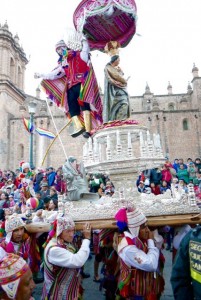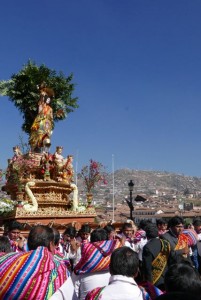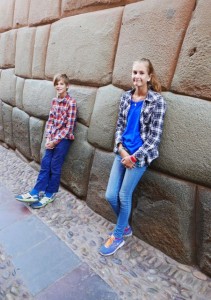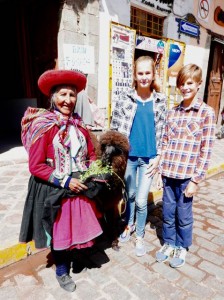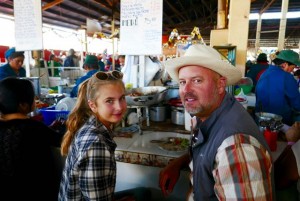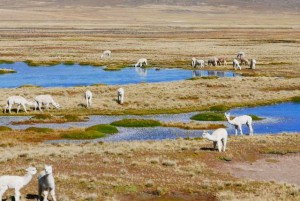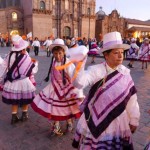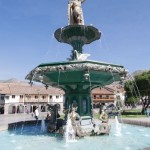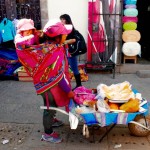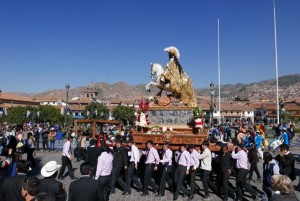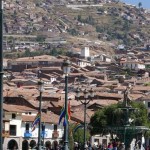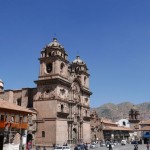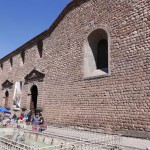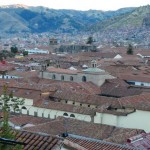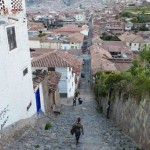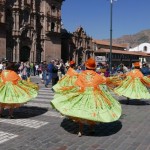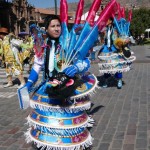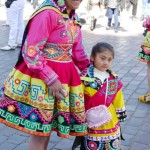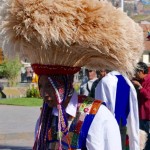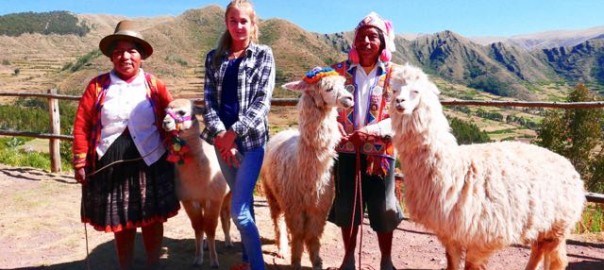Lima, the capital city of Peru has a population of about 10 million residents. The slums alongside the brown mountains that look over the city make up about 1/3 of all that. Miraflores, the upscale district where we stayed in had many nice restaurants and shopping malls. Aside from the historical center, the rest of Lima was dingy, with half-finished cheap cement buildings and trash piling up alongside sidewalks and blowing into the sewers that smell like any large city sewer. No, I did not care much for Lima, or for the dusty, barren mountains with the big Jesus looking over them. We took this bus company called Peru Hop all the way from Lima to Cuzco. These weren’t like the bus we took from the Amazon to Quito, no, these were big buses with comfortable reclining seats and lots of leg room. The fun thing was, we never spent that much time in the bus anyway, we took tours most of the time.
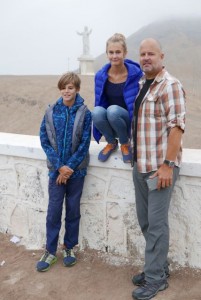
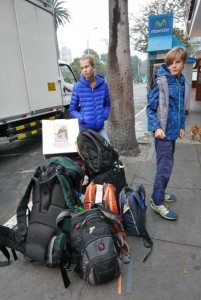
Nous voici à Lima, la capitale du Pérou qui compte un peu plus de 10 millions d’habitants. Une grande partie de la population est arrivée des Andes et s’est greffée dans les banlieues en créant des bidons villes. Nous logeons à Miraflores la banlieue chic de la ville, avec ses parcs, vue sur l’océan et ses fameux restaurants. Mis à part un tour dans le centre historique de la ville, il n’y a pas beaucoup de charme à Lima, une grande ville surpeuplée et polluée. La ville a été créée par Pizarro sur un désert jaune où rien ne pousse, j’avoue que je n’ai pas trop aimé cette mégapole sans charme. Nous avons parcouru le Pérou avec la compagnie de bus Peru Hop entre Lima et Cuzco. Mais leurs bus étaient bien, on pouvait regarder des films et ils faisaient souvent des stops avec quelque chose à visiter.
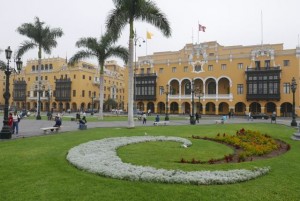
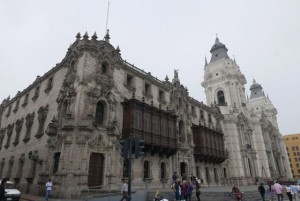
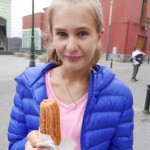
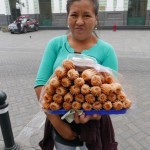
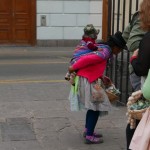
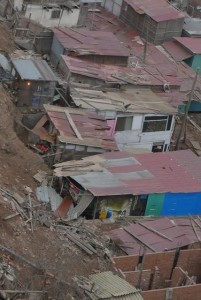
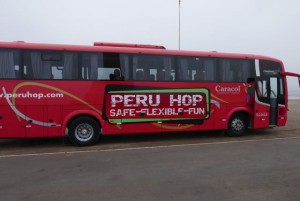
Like on the first day, we visited a beautiful Spanish Mansion with slave tunnels. It was horrible down there. I inhaled dust with every breath and at times the walls and ceiling were so tight, that I was almost walking on all four on the dirt floor. Then we stayed the night in Paracas, a small sea side town with an island just off the coast which is nicknamed the poor man’s Galapagos. There I saw numerous sea faring birds like sea gulls, red-footed Nazca boobies, and my favorite, penguins! They ae the cutes birds I have ever seen! These particular ones were only about a foot high, and they waddled and hopped from rock to rock in the most adorable way. The lack of sea lions was made up with the abundance of birds. They covered the cliffs and flew all around our speed boat (I got lucky that they didn’t poop on me, the people behind weren’t so lucky)! On our way back in, We saw a pod of 20 or so bottle-nosed dolphins! They were much larger than the ones we saw in Australia, though they also didn’t come within 4 meters of the boat.
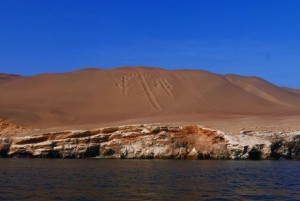
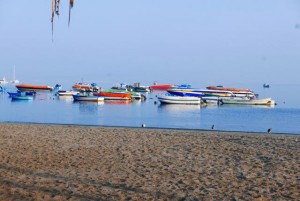
Par example, le premier jour en route pour Paracas nous avons fait une halte dans une ancienne Hacienda (devant un hôtel maintenant) espagnole qui avait des esclaves venus d’Afrique. Les propriétaires ont fait construire des tunnels (plus ou moins 25km) par les esclaves qui allaient jusqu’à la mer, comme ça ils ne déclaraient pas leurs esclaves mais les cachaient dans les couloirs pour ne pas payer les impôts. Nos avons fini notre journée à Paracas, petite bourgade au bord de mer qui est surnommée les Galapagos des pauvres. Nous avons fait un tour dans un bateau rapide pour visiter les iles Ballestas qui ont une grande diversité d’espèces aviaire. Nous avons vu beaucoup de mouettes, pélicans, des petits pingouins (qu’on n’avait pas vu aux Galapagos). Il y en avait tellement qu’ils recouvraient les ilots des Ballestas. Nous n’avons pas vu énormément de lions de mer car ils sont plus là en octobre mais nous avons pu en observer quelques-uns. Juste avant notre retour dans le port nous avons pu admirer une 20aine de dauphins, ils ne sont pas venus aussi près du bateau qu’en Australie mais c’est toujours beau de les voir surfer dans l’eau.
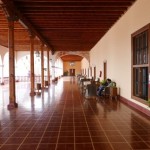
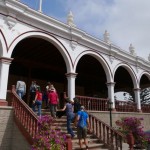
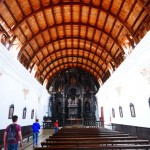
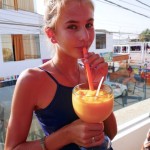
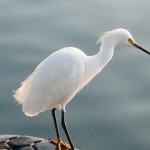
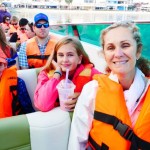
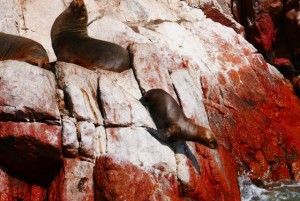
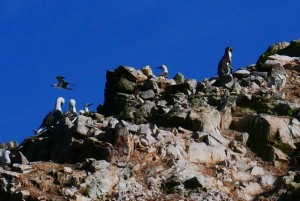
That afternoon we arrived in another town called Huacachina, I just called it cappuccino, because that’s what it sounded like to me when I first heard that name. It was an oasis in the middle of 300 foot sand dunes. With my dad, brother, and other people from our bus, we took a buggy ride through the dunes. We got off to a bad start because we got the worst, most rotten buggy in the bunch, and our driver was 15 minutes late because he decided to get a last minute ice cream and bathroom break. But then it was all fine when we started driving over the dunes. It was a very bumpy ride, the people in the back were jostled and shaken from side to side. Then the time came for sand boarding. I was cautious and decided not to injure myself on the first ride, so I went on my stomach. And then I sat down, but forgot to strap myself in, so I flew off about midway down the dune. And then I got brave enough to stand up like a real snowboarder. I zoomed down the hill as if I had rockets attached to the back of the board. I don’t know how I managed to stay standing up the whole time, but I lasted 2 more successful rides before smashing face-first into the sand. After that I was pretty inconsistent with my rides, sometimes I would stick a perfect landing, and other times I would be biting the dust. The sunset over the colossal sand dunes was beautiful, I felt like I was on an African safari. I didn’t want it to end, but time flies when you’re having fun, and all good things must come to an end someday. Afterwards, I had sand EVERYWHERE. I think I dumped at least a pound of it from my sneakers alone. The next morning I decided to climb the biggest dune of all which bordered the hotel. It’s a lot harder than you might imagine. For every two steps that I took, I slid down one. My progress was slow and in every way inconsistent. So an hour had gone by, by the time I reached the crest. And then I did the stupidest thing possible, I sprinted immediately down its face. Oh, but what a feeling. I felt like I was flying! I took big leaps while trying to avoid the miscellaneous trash heaps on the sand. It took less and a minute for me to reach the bottom and jump into the frigid water of the swimming pool.
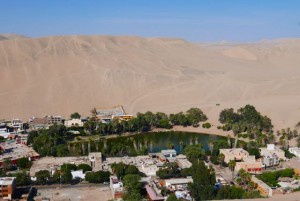
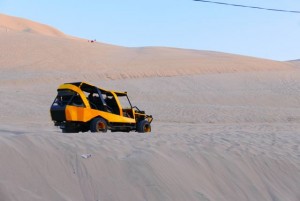
Après une heure de bus nous sommes arrivés à Huàcâcina, je l’appelle cappuccino car la première fois que j’ai entendu ce nom j’ai cru qu’ils parlaient de cappuccino. C’est un oasis, eh oui comme dans Tintin, un petit lac avec des dunes de sable géantes autour. Juste le temps de poser nos valises et me voilà partie pour un tour en buggy et surfe sur les dunes. Notre chauffeur de buggy est arrivé 15 min en retard car il était allé se chercher une glace. Mais bon, il a été pardonné après le fun avec le buggy, ça secoue beaucoup quand même. Quand nous avons commencé le surf sur le sable pour ma première descente j’ai été très prudente sur le ventre, pour la deuxième sur les fesses, j’avais oublié de m’attacher et au milieu je me suis viandé. Puis j’ai essayé de me mettre debout, et j’y suis arrivée, je ne sais pas trop comment mais c’était super. J’ai réussi à faire 2 autres descentes super bien avant de me retrouver visage premier dans le sable. Après, dans mes descentes il y avait du bon et du moins bon. J’ai admiré le coucher du soleil sur les dunes c’est toujours magique. C’était super nous avons passé une super après midi. De retour à l’hôtel, j’avais du sable de partout, vraiment partout.Le lendemain matin, nous avons escaladé les dunes à pied, je dois dire que cette experience est beaucoup plus difficile que ça ne parait, pour 2 pas que tu fais tu descends d’un. Il m’a fallu presque une heure pour atteindre le sommet. Une fois arrivait j’ai dévalé la pente à toute allure, j’avais l’impression que je volais, il ne m’a fallu que quelques minutes pour atteindre le bas et me jeter dans la piscine froide.
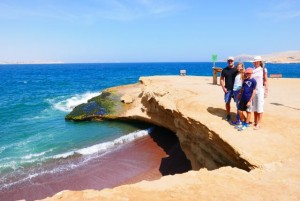
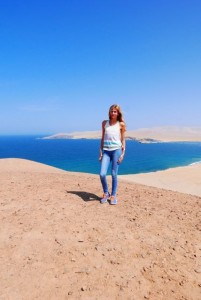
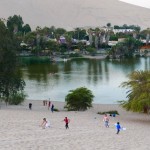
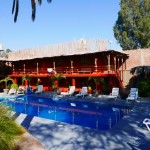
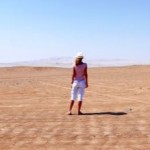
And then, guess what we did next? We hopped onto the bus again! Yay! I absolutely LOVE staying on big, cold buses all night long! No, we stopped twice, once for dinner and then to go see the Nazca Lines. There are many theories about these ancient figures; some people say that they were created by aliens, others think that it was a very ancient civilization. Nobody knows for sure who made them, or when, and I don’t think we ever will any time soon, but one thing is certain, they were made by someone. And they are big and can only be seen from above, so whoever made them must have known what they were doing. They’re mostly primitive figures of animals drawn about 8 inches deep into the gravely sand. There is nothing out there (except the Nazca Lines of course), and a flat expanse of desert with mountains in the distance. I probably spent more time writing this passage than I actually spent there. We watched a few movies in the bus, but I couldn’t sleep, not even when we arrived at our hotel in Arequipa.
Devinez ce que nous avons fait après? Eh bien, oui retour dans le bus pour un autre long trajet. Et cette fois-ci pour toute la nuit! Nous avons quand même fait 2 arrêts, 1 pour diner et un autre pour admirer les géoglyphes de Nasca. Ce sont des lignes dans le désert qui forment des dessins, elles sont très anciennes et on peut les admirer seulement en hauteur. Il y a plusieurs théories pour expliquer leur apparition, notamment des extra terrestres seraient venus et les auraient faite. En fait, personne ne peut les expliquer, elles ont été découvertes en 1927. Mais elles sont là donc quelqu’un les a dessinées dans un sol aride mais pas sablonneux très dur, elles font plusieurs km de long et jusqu’à 1 m de large pour les plus grandes, 15cm de profondeur. Mystère. Dans cet endroit, c’est le désert complet pas un brin de végétation ne pousse, donc après avoir vu certains géographes nous sommes repartis. Pour faire passer le temps plus vite nous avons pu visionner des films dans le bus, ça a fait passer le temps car je n’ai pas dormi.
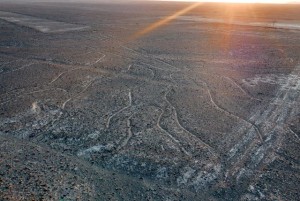
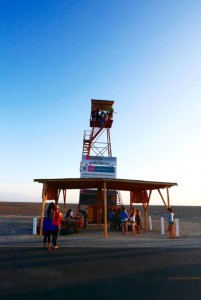
You could really see the Spanish influence in that town. The architecture was beautiful; inner courtyards, bright red, yellow, and blue colored paints everywhere, ornately carve wooden balconies, big stone carvings, and big churches. I thought that the style of architecture in Arequipa was nicer than in Cuenca, only because the whole city was the same Spanish style, not just three or four buildings. The markets there were really colorful, and the food was so tasty. We went to visit the old St. Catalina monastery for nuns. It was built in 1600 and is still in use today. The nun’s parents sent their daughters there around the age of 11 to get an education. Not all of them would become a nun, and they could leave the monastery if they didn’t like it as well. The grounds were so vast, it almost felt like an entirely new village! After passing three big courtyards, we came upon the place where the nuns used to reside. Where as in Europe, where the nuns all sleep in the same dorm and eat together, there, they all had their own private apartments with small gardens and kitchens with big stone fireplaces. In addition, there were small chapels more or less around each corner. I tried one of Peru’s specialties in Arequipa; Chica de Morada. It’s a drink made from blue corn. I know what you’re thinking, that a corn drink is weird, but surprisingly, it was really delicious and sweet. We could only spent a couple of days in Arequipa, because Cusco was the next stop.
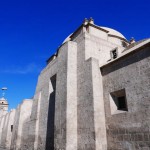
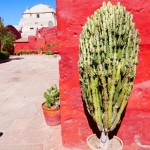
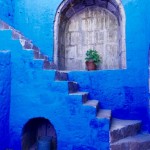
Nous sommes arrivés à Arequipa vers 5h45 du matin, il faisait froid car nous sommes dans les Andes maintenant. J’ai tout de suite remarqué une grande influence espagnole dans l’architecture dans cette ville. J’ai beaucoup aimé cet endroit, il y avait beaucoup de fer forgé, de patios, des couleurs vives, des balcons en bois ornés et bien sur beaucoup d’églises. J’ai préféré ici à Cuenca en Equateur, parce que toute la ville était belle pas seulement le centre. Le marché était très coloré et la nourriture très bonne.Nous avons visité le monastère de St Catalina, pour des soeurs construit en 1600. Encore aujourd’hui, il y a une petite communauté de soeurs. Les parents des futures nonnes les envoyaient dans le couvent vers l’âge de 11 ans pour qu’elles soient éduquées, ou bien les veuves venaient finir leurs jours ici. Certaines finissaient nonnes ou bien elles en sortaient après 18ans.Ce couvent est comme un village avec des rues, plusieurs chapelles etc. Il est très différent des autres parce que chaque nonne avait son propre logement, généralement une chambre et une cuisine, pour les plus riches elles avaient une servante. Les rues étaient très colorées avec du bleu, du rouge, du orange, cela formait un ensemble architectural très esthétique. Dans cette ville j’ai goûté une boisson du Pérou appelée Chicha morada, à base de maïs violet fermenté. Vous pensez qu’une boisson à base de maïs semble étrange, oui mais en fait c’est bon. Nous n’avons passé que 3 jours à Arequipa mais j’aurais pu en passer largement 8. Il fallait partir pour Cusco.
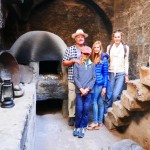
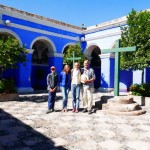
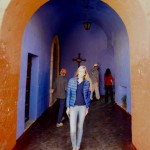
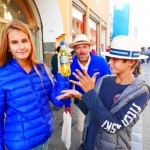
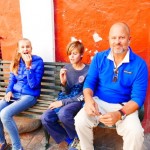
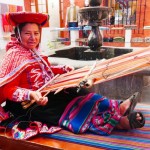
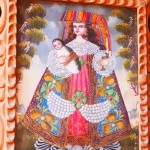
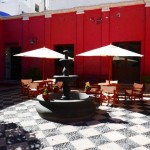
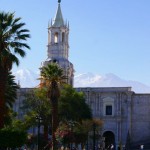
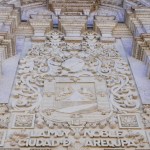
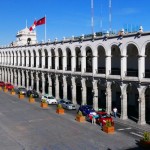
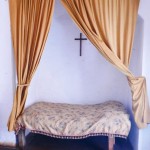

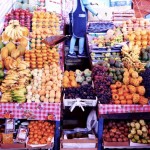
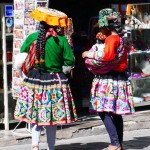
I spent 12 straight hours in a bus (without any bathroom breaks, can you imagine)? I felt so sick, both with the constantly rising elevation, and the serpentine roadways. With every bend in the road, my stomach churned, my kidneys rebelled, and my head throbbed. When we finally arrived in Cusco, I felt like I was dying. I was too nauseous to notice the parade of people dancing in traditional costumes going on in the main square, or the wooden saints being carried by men into the cathedral. In fact, I stayed in the hotel room until dinner time. Cuzco, the ancient Inca capital is 2,800 feet higher than Arequipa, that’s almost 10 Eiffel Towers stacked up on top of each other. What did I do in Cusco? Well, I walked, a lot. I walked through narrow, paved streets with ancient Incan stones lining all the buildings. I walked through huge covered markets where the smell of dried lamb’s head and freshly fried pork’s feet hung in the air like an old blanket. I ate there too. But not the two repulsive (I find the repulsive) foods I just mentioned to you, I had stir fried lomo with papas fritas and arroz, and crunchy dulce de leche-stuffed churros for dessert. We were lucky to be in Cuzco during Corpris Christi, a big holiday for the Peruvians. It’s when they make big statues of the saints and they carry them around the town, bringing them into all the most important cathedrals and churches. The majority of people living in Cusco was mobbing the main square. There wasn’t any room to move, and it was just as difficult to see the parades. My favorite part was the music. A marching band in tuxedos was proceeding each saint, 100 decibels of the loud, festive music resonated in my heart, and also in my ears. I used to play in a band, that’s probably why I have sensitive ears now! Cusco, I noticed, like all South American cities, stretched out far and wide when I was overlooking it on top of a mountain. That would be the second to last time I would see it from up above, for the preceding day, we left on a day trip, and didn’t return for 4 days…
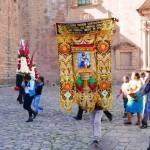
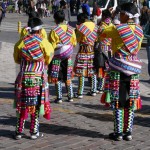
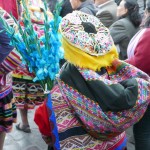
Nous avons passé 12 h dans le bus sans nous arrêter pour un arrêt pipi(il y avait des toilettes dans le bus). Je n’ai pas aimé ce trajet avec les routes sinueuses de montagne et le fait que nous montions à une très grande altitude. J’avais mal à la tête, mal au ventre une vraie agonie. Une fois à Cusco, ça ne ‘est pas arrangé tout de suite. Je n’ai pas vu les gens parader dans la rue en costume, les Saints qui défilaient, je suis restée dans la chambre d’hôtel tellement j’étais nauséeuse. Cusco est à 3400m, je dois dire que l’altitude m’a rendue malade, mais nous étions dans l’ancienne capitale de la civilisation Inca, la ville qu’ils appelaient le Centre du Monde. C’est une ville intéressante de part son histoire, on trouve des rues avec les pierres d’anciens temples Incas à la base (car les Espagnols ont tout détruit pour construire leurs églises!). Nous avons visité le marché avec les têtes d’agneaux sur les banques ou les pieds de porc, je ne vous raconte pas les odeurs quand on est pas très bien.Nous avons mangé sur place, Jayden n’était pas très d’accord mais l’endroit où nous avons mangé était correct, lomo con papas fritas y arroz, boeuf sauté avec des frites et du riz. Et des churros avec dolce de leche pour dessert arrosé par un jus de sucre de canne. Nous avons été très chanceux d’être à Cusco pour Corpus Christi, une fête religieuse très importante. Il y avait des défilés, les gens portaient le costume traditionnel, chaque groupe avait sa fanfare pour accompagner les 13 Saints, c’était spectaculaire. Il y avait une foule très importante, c’était parfois difficile pour voir le défilé. La fanfare accompagnant chaque Saint était très bonne, la musique était entrainante même si elle était une peu trop forte. Ca m’a rappelé quand je jouais de la musique à Bement mon école. Nous sommes montés assez haut dans la ville pour admirer la vue, les maisons s’étalaient sur des km et des km. Puis nous sommes partis pour la vallée sacrée, une autre partie fantastique du Pérou.
